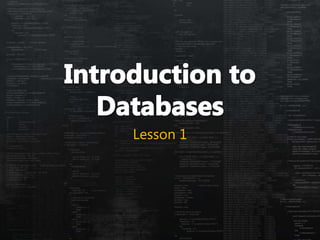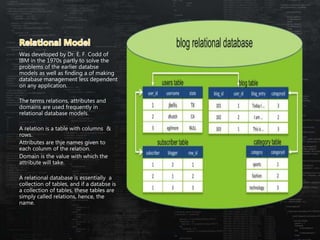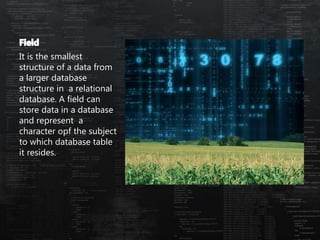Ad
Introduction to databases
- 1. Lesson 1
- 2. A database is a collection of organized data, information and records.
- 3. Database is information that a person needs in his personal, business, social and religious life and the power and purpose of information is not only in collecting and finding them but more importantly in using them.
- 4. Structured database It is also called the structured data in which a record or file of information arranged in uniform format. These databases are usually storage of information with similar entries such as a list of persons born in a country, a medical database of patients’ data, an inventory database of a company and many others. Free-form database It is a loose collection of information, such as those you will find on the World Wide Web. A collection of your documents in the computer made from several programs can be considered as free-form database.
- 5. Operational database It is a dynamic database that is used by any organization in its day-to- day operation. They are used to collect data, maintain, modify and delete data. Analytical database It is a static database, where data is rarely modified. This database is often used to store and track historical data to make long term projections and analysis.
- 7. This model can be visualized as a parent –child relationship wherein a child may only have one parent but parent can have several other children. Another way of looking at this model is by visualizing an inverted tree. The single table acts as the root of the inverted tree and the other tables act as branches. To access the data from one of the tables, one has to pass through the root table. This model was popular in the many IBM Information Management Systems in the 1970s using mainframe computers.
- 8. This model was developed to address in part the problems of the hierarchical model. As with heirarchical model, it could be visualized as an inverted tree; however, this model allows many inverted tress sharing branches but are still part of the same database structure. As with the parent-child model, the child is allowed to have multiple parents. Unlike in the heirarchical model access data begins from the root table. In the network model, it allows access of data from any table . This model was eventually replaced by the relational database model.
- 9. Was developed by Dr. E. F. Codd of IBM in the 1970s partly to solve the problems of the earlier databse models as well as finding a of making database management less dependent on any application. The terms relations, attributes and domains are used frequently in relational database models. A relation is a table with columns & rows. Attributes are thje names given to each colunm of the relation. Domain is the value with which the attribute will take. A relational database is essentially a collection of tables, and if a databse is a collection of tables, these tables are simply called relations, hence, the name.
- 10. Entity-relationship Model This model was written by Peter Chen in 1976. This model is an abstract and coceptual representation of data. Dimensional Model Object-relational model Is a specialized adaption using the relational model that is used to represent data in data warehouses. Data warehouses is essentially storage of all dgital data of a company or organization. In this model, a single large table of information is used using dimensions and measures. Dimension tells where, who and what type while measure would mean quantity. Is a model that utilizes the relationship model as well as the object- oriented programming paradigm. This model attempts to bring together database and application programming closer together.
- 11. RDBMS is designed to creat,e, maintain, manipulate,, modify and delete information in a relational database. As previously mentioned, moderm database utilize the relational database model and many of today’s software caters to this type of structured database.
- 12. Create a database Information storage Information retrieval Information management Information analysis Print and share information
- 14. It is a number or value found and stored in the database. Data is static because it remains the same until it is modified by a process.
- 15. It is a data that has been processed thereby making it. Relevant and meaningful to the person viewing it.. Information is dynamic because it changes relative to the data stored in the database and it could be processed in many ways.
- 16. It is used to represent a value that is unknown or missing. A null value is niether a zero nor a blank.
- 17. It is the main structure in the relational database. It is composed of attributes (fields) and domain (records). A table almost always represents a subject that can be an object (person, place, or thing) or an event.
- 18. It is an organized collection of data about an entity. As an example, for a bookstore, a file called “Branch” can contain all the data about a particular bookstore branch.
- 19. It refers to a specific person, place, thing, or event. Record is also known as the “tuple” in the relational database terminology. It pertains to structure in the database table representing a unique instance of a subject.
- 20. It is the smallest structure of a data from a larger database structure in a relational database. A field can store data in a database and represent a character opf the subject to which database table it resides.
- 21. It is also known as a virtual table . It is called a virtual table since it does not hold data on its own; rather it gets data from the table which it is based. And since it comes from other table it is composed of several fields coming from one or more data.
- 22. These are fields that serve specific purposes within a table. There are two types of keys, the primary key and the foriegn key . The Primary key is a field that uniquely identifies a record in the table. The Foreign key is a special field that establishes a relationship between two tables.
- 23. They exist when two or more tables have connection or association .
- 24. Primary key Foreign key Linking table is a table that establishes a connection between two or more tables
- 25. When two or more tables are related, there exist between them a specific type of relationship and there are three types of possible relationships.
- 26. This relationship exist between tables when only one record of the first table is related to only one record to a second table, and only one record of the second table is related to only one record to the first table.
- 27. This relationship exist between tables when one record of the first table can be related to one or more records to a second table, but only one record from the second table can be related to a single record in the first table. This relationship is the most common relationship that exist between tables and helps to reduce or eliminate duplicate and redundant data.
- 28. This relationship exists between tables when one record of the first table can be related to one or more records to a second table and one record drom the second table can be related to one or more records to the first table. The connection between the two tables will be difficult to establish and will resullt to redundant data in one of the tables.
- 29. Define the purpose of your database. Consider the questins or queries you may want to answer about the stored data. Determine the tables that you need in the databse. Determine the fields that you need in the database. Identify unique fields values that you will allow Access to connect information stored in a separate table. Determine the relationships between tables. A relationship works by matching data in the key fields which is usually a field with the same name in both tables. Test the design by entering the sample data. Check that you can run a query on the database and get the information you want.
- 30. Modify data is easy. Changes to the value of one field within the table should not affect the values of the fields in the table. Retrieving information is easy. Extracting desired information from tables with well defined relationships should make accessing and retrieving data a lot faster. Developing and building user application is easy. Data manipulation would be the main focus of programming and not solving the problems associated with a poorly designed database. Maintaining the structure is easy. Changes made to any table. Or columns should not affect other tables or columns. Adding and deleting data is easy.
- 32. A spreadsheet is very powerful if used properly; however, it is designed for a purpose and always will find a purpose within any business or organization . Spreadsheets do not make good relational database, because if you really need to acquire and collect, store and maintain, view and analyze, print and share data then you need a tool that will truly suit in designing a real database.
- 33. Secondly, you should also get away from the “spreadsheet view” mentality. Spreadsheets may seem to offer a good means to view data; however, a database program may not be able to produce a report of a spreadsheet layout. A database presentation may not be the same as that of a spreadheet but it could be just as clear.
Editor's Notes
- #3: Whenever you make a list of anything – list of groceries to buy, books to borrow from the library, list of classmates, list of relatives or friends, list of phone numbers and so o – you are actually creating a database. An example of a business manual database may consist of written records on a paper and stored in a filing cabinet. The documents usually organized in chronological order, alphabetical order and so on, for easier access, retrieval and use. Computer database are those data or information stored in the computer. To arrange and organize records, computer databases rely on database software Microsoft Access is an example of database software.
- #4: Examples of everyday life database
- #6: OD An exampke of operational database is the inventory database which constantly changes as the company go about its daily business deals. AD An example of an analytical database includes data on global temperature to determine the effects of global warming in certain areas for a period of time.
- #13: Personal and business database need to be created and RDBMS programs will help facilitate this process. Database creation is made easier and faster because of these programs. Many of them have templates to choose from so you do not have to start from scratch; however, if needed you can also start with your own. Once your database is created, it is now easy to add information into your database. For example, if you have a list of mp3 music in your computer, as new music becomes available you simply add this data into your database and categorize it to the attributes you have created, whether it is jazz or rock, classical or modern. You can also rate it as one of the favorites. A database program allows you to add, organize, modify, edit and delete your information as you deemed fit.
- #25: Relationships in relational database exist when two or more tables are connected by the following conditions: Relationships are important because they ensure data integrity since they eliminate duplicate and redundant data. Relationships also help as a means to define views.
- #27: Although the fields in these tables could be combined into a single table, the database designer chose to place the fields that can be viewed by anyone in the organization in the EMPLOYEES table and the fields that can be viewed only by authorized personnel in the COMPENSATION table. Only one record is required to store the compensation data for a given employee, so there is a distinct one-to-one relationship between a record in the EMPLOYEES table and a record in the COMPENSATION table.
- #28: A customer can check out any number of videos, so a single record in the CUSTOMERS table can be related to one or more records in the CUSTOMER RENTALS table. A single video, however, is associated with only one customer at any given time, so a single record in the CUSTOMER RENTALS table is related to only one record in the CUSTOMERS table.
- #29: A student can attend one or more classes during a school year, so a single record in the STUDENTS table can be related to one or more records in the CLASSES table. Conversely, one or more students will attend a given class, so a single record in the CLASSES table can be related to one or more records in the STUDENTS table.














































































































